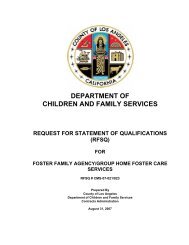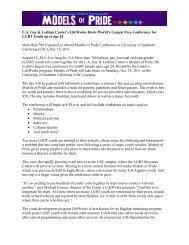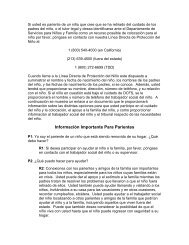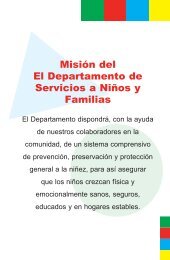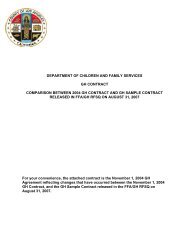DCFS News Winter Issue (PDF) - Los Angeles County Department ...
DCFS News Winter Issue (PDF) - Los Angeles County Department ...
DCFS News Winter Issue (PDF) - Los Angeles County Department ...
Create successful ePaper yourself
Turn your PDF publications into a flip-book with our unique Google optimized e-Paper software.
D C F S NEWS<br />
MESSAGE FROM THE DIRECTOR<br />
Continuing to Build on<br />
Our Success<br />
It’s the end of the year, and I’d like to again congratulate<br />
all <strong>DCFS</strong> staff on working to achieve the department’s<br />
three goals. The work that’s been done this year has been<br />
exceptional. We’ve seen improvements in most areas of<br />
performance including safety and permanence.<br />
Due to the incredible work being done in offices, we are<br />
doing better than the State averages in some key areas<br />
such as recurrence of maltreatment and the rate of recurrence<br />
of abuse and/or neglect in homes where children<br />
were not removed. Most notably, in the last year we have<br />
decreased the abuse and/or neglect rate for children in<br />
foster care by approximately 31 percent and we have<br />
decreased the median length-of-stay for children in out-ofhome<br />
care by 20 percent.<br />
Two years ago the department had 800 more cases<br />
open and 100 less social workers. Because of your hard<br />
work keeping families together and closing cases when<br />
appropriate, we have been able to reduce the number of<br />
children in out-of-home care and gained support for the<br />
hiring of more workers. Over the last year, we have<br />
decreased the number of children in foster care by approximately<br />
10 percent and new entries into care by approximately<br />
17 percent.<br />
Today we also have 398 Supervising Children’s Social<br />
Workers, up from 296 two years ago. Caseload averages<br />
have dropped slightly from the 30s to the upper 20s and we<br />
will continue to work on this.<br />
The one area where we need further concentration is<br />
permanency. Although our Permanency Plan cases are<br />
down from 18,000 to 16,000, we still need to focus on<br />
improving timelines to permanency and work hard on<br />
closing the thousands of Permanency Plan cases that are<br />
currently open by finding permanent homes for these<br />
children. Focusing on the importance of allocating<br />
resources where they are needed most continues to be a<br />
priority in providing the safety and stability to the families<br />
we serve.<br />
You should be proud of all of these accomplishments<br />
and take time out in each of your offices to celebrate your<br />
success. The department is well on its way toward being a<br />
national model for how social work should be done. In the<br />
new year, we will continue to celebrate our achievements<br />
and continue to focus on what it takes to be exceptional.<br />
David Sanders, Ph.D.<br />
Director<br />
Inside This <strong>Issue</strong>:<br />
2 Success Stories<br />
4 Res-Wrap Program<br />
5 On the Line<br />
Five Strategies to Support<br />
Three Key Outcomes<br />
Continued on Page 3<br />
Information for Employees of the <strong>Los</strong> <strong>Angeles</strong> <strong>County</strong> <strong>Department</strong> of Children and Family Services<br />
6<br />
SPA Spots<br />
8 Employees of the Month<br />
Earlier this fall, the <strong>Los</strong> <strong>Angeles</strong> <strong>County</strong> <strong>Department</strong> of Children and<br />
Family Services (<strong>DCFS</strong>) announced five strategies to support the<br />
department’s key three outcomes of improved permanence,<br />
improved safety and a reduction in the reliance of out-of-home-care.<br />
(See box on this page.)<br />
Some of the strategies, such as the Permanency Partners Program (P3) are<br />
new concepts, but other methods like Team Decision-Making have been used<br />
by staff for years. But they all have one thing<br />
in common -- all of the strategies were<br />
found to be those that best support the<br />
department’s three goals. Many of these<br />
same strategies are now being implemented<br />
throughout the country by other child<br />
welfare agencies.<br />
“These five strategies are proving to be<br />
successful in improving safety and permanency<br />
for children and families,” said<br />
<strong>DCFS</strong> Director Dr. David Sanders. “By<br />
focusing our efforts, we will be better able<br />
to achieve the three goals we have set.”<br />
In this issue of “<strong>DCFS</strong> <strong>News</strong>” we give<br />
you a brief overview of each of the<br />
strategies. More information and in-depth<br />
fact sheets outlining each strategy are<br />
located on the L.A. Kids web site, along<br />
with a video message from Dr. Sanders<br />
explaining how the five strategies support<br />
the three outcomes.<br />
Point of<br />
Engagement (POE)<br />
The department began developing POE<br />
in 1999 in response to an audit recommendation<br />
that the department revise its case<br />
flow process and provide a faster response<br />
for services. A POE pilot began last year in<br />
<strong>Winter</strong> 2005<br />
THE KEY THREE:<br />
Improved Permanence<br />
Improved Safety<br />
Reduced Reliance on<br />
Out-of-Home Care<br />
FIVE STRATEGIES:<br />
1.Point of Engagement<br />
(POE)<br />
2.Permanency Partners<br />
Program (P3)<br />
3.Concurrent Planning<br />
(CP)<br />
4.Structured<br />
Decision-Making (SDM)<br />
5.Family to Family/<br />
Team Decision-Making<br />
(F2F/TDM)<br />
the Compton office and full implementation is expected to be in all offices by<br />
next year.<br />
POE is characterized by a seamless and timely transfer of responsibility<br />
from front-end investigations to actual service delivery. This seamless delivery<br />
will provide more thorough evaluations and provide more comprehensive<br />
services to families, often preventing low-risk cases from entering the court<br />
system altogether. When possible, community services are provided to help<br />
the family while it is kept safely intact.<br />
POE will not be appropriate for every family. The department uses Structured<br />
Decision-Making to identify families who could benefit from POE.<br />
POE also uses a team decision-making approach and includes input from the<br />
1
2<br />
<strong>DCFS</strong> Success Stories<br />
As a regular part of "<strong>DCFS</strong> <strong>News</strong>," we recognize the successes of the <strong>Los</strong> <strong>Angeles</strong> <strong>County</strong> <strong>Department</strong> of Children and Family<br />
Services (<strong>DCFS</strong>) and its community partners. These success stories are diverse and offer an opportunity for staff and community<br />
partners to celebrate accomplishments and share the good work they are doing. To submit story ideas for this section, please e-mail Stuart<br />
Riskin of the <strong>DCFS</strong> Office of Public Affairs at riskis@dcfs.co.la.ca.us. In this edition of “<strong>DCFS</strong> <strong>News</strong>” Success Stories we highlight the<br />
importance of mentoring.<br />
Volunteer of the Year Sees Value<br />
in Mentoring<br />
Former Foster Youth Uses His Struggle<br />
to Inspire Others<br />
“Years ago, I<br />
Alan “Irie” Reyes,<br />
learned that kids get<br />
a 28-year-old mentor-<br />
kicked out of foster<br />
ing coach at the All<br />
care at 18 and I<br />
Peoples Christian<br />
remember feeling<br />
Church, knows a lot<br />
that this was terrible<br />
about what it’s like<br />
for someone so<br />
to be in the system<br />
young to be left<br />
and struggle through<br />
adrift on their own,”<br />
a difficult childhood.<br />
explained <strong>DCFS</strong><br />
Reyes is part of the<br />
2005 Volunteer of<br />
Exodus Urban<br />
the Year Dorothy<br />
Academy gang<br />
Simpson. But, it<br />
i n t e r v e n t i o n<br />
Dorothy Simpson wasn’t until years<br />
later when she<br />
Irie Reyes and his foster parents<br />
program. He now<br />
uses his struggles<br />
learned about the need for mentors from an article in the “<strong>County</strong> and success in life to inspire and teach middle school and high school<br />
Digest” that she was inspired to volunteer. “My reward for mentoring continuation school students.<br />
is the knowledge that I am supporting someone who really needs it.” Reyes speaks to youth on probation and parole and goes to Home-<br />
Simpson now mentors a young woman who is in the process of boy Industries and Destiny Girls Academy, a continuation school for<br />
emancipating from the foster care system. She offers encouragement, girls on a weekly basis to meet with at-risk youth. Reyes is familiar<br />
advice and friendship to the youth, who has been supervised by the with pain and loss and he said that helps him relate to the youth. He<br />
department since she was 13 years old and suffers from self-esteem has lost several family members to gang violence including three<br />
issues. They see each other every other week and talk weekly or as cousins in just the past five years alone.<br />
often as the youth needs. Simpson takes her mentee to the beach, Reyes ended up in foster care when he was six years old. His<br />
movies, museums, shopping and to various musical events. “I want to mother and father had split up years earlier and his father moved to<br />
expose her to a range of cultural and artistic activities.”<br />
New York City. During his early years, Reyes was raised by his home-<br />
The pair has been together for almost two years. There have been less mother who was addicted to drugs. He entered the foster care<br />
ups and downs for this young person, but over time Simpson has seen system after he and his older brother were caught stealing food<br />
positive changes. The young woman really wants to come out of her because they were hungry.<br />
shell and take a more proactive stance in her life. She has sought out “I remember it like it was yesterday,” he said of the day police<br />
professional help and has re-enrolled in school and is looking for a showed up at a convenience store where he had just stolen candy bars.<br />
new job. Most of all, she needs a friend – and that’s the most important “They told us we would be taken to a nice home.”<br />
part of mentoring, explained Simpson. Simpson has this advice for His foster parents treated the two boys like family. Reyes remem-<br />
present and future mentors: “A mentor should not run the mentee’s life bers those years as happy times. The couple wanted to adopt the<br />
or try to be a parent. Be a good listener and spend time together doing brothers, but custody was eventually returned to their father who<br />
activities.”<br />
wanted to raise the boys in New York. Reyes’ teen years with his<br />
The department is currently in the process of creating a formal father were tumultuous. He got kicked out of school, was in and out of<br />
Mentoring Section to provide all foster youth with a mentor.<br />
jail, selling weed and just “hanging out.” After returning to <strong>Los</strong> <strong>Angeles</strong>,<br />
Reyes got involved working with youth first through “Dream<br />
Yard” a program that goes into juvenile camps and facilitates poetry<br />
For more information on how to become<br />
sessions. He turned his life around and found purpose. Since then,<br />
Reyes has developed a passion for poetry and music. He has also<br />
a mentor for <strong>DCFS</strong> foster youth, call the<br />
Emancipation Division Info Line at<br />
started his own business selling shirts and provided commentary for<br />
Youth Radio.<br />
“One of my ultimate dreams is to have a non-profit and work with<br />
(213) 351-0100.<br />
foster youth who are emancipated,” he said.<br />
To view Reyes’ poem “Memory Lane” and hear his story in his<br />
own words, log on to Youth Radio at<br />
http://www.youthradio.org/poetry/kpfa050129_lane.shtml.
Five Strategies to Support Three<br />
Key Outcomes<br />
Continued from Page 1<br />
Permanancy Partners Program (P3)<br />
No child should leave foster care without a lifelong<br />
connection to a committed adult. That’s the philosophy<br />
behind P3, a new effort to assist social workers in finding<br />
legally permanent homes and adult connections for the<br />
more than 7,000 youth ages 12 to 18 who are currently in<br />
long-term foster care placements in <strong>Los</strong> <strong>Angeles</strong> <strong>County</strong>.<br />
Piloted a year ago, P3 pairs a specially trained<br />
“permanency specialist” with a youth to identify one or<br />
more adult connections with the goal of reunifying the<br />
youth or moving the youth into adoption or legal<br />
guardianship. At the minimum, P3 hopes to connect each<br />
child with an adult mentor.<br />
Retired social workers have been rehired to help offices<br />
with this effort. In addition, volunteer private investigators<br />
will be used to find adults who youth have identified as<br />
significant, but have lost contact with over the years. More<br />
than 250 youth are now being served by P3 in 16 offices.<br />
“We are beginning a cultural shift,” said Director Dr.<br />
David Sanders. “We need staff to start embracing the<br />
concept that legal permanency for foster children is<br />
achievable and that it is urgent.”<br />
Concurrent Planning (CP)<br />
Concurrent Planning aims to support timely permanence<br />
for children. Safe reunification is <strong>DCFS</strong>’ first priority, but<br />
in the event that this is not possible, Concurrent Planning<br />
ensures that the identification of an alternative placement<br />
plan for children who cannot safely return home is in place<br />
from the beginning.<br />
Working with a labor/management group, the department<br />
implemented changes to Concurrent Planning which<br />
support the safety and permanence for children and<br />
families from the first day they enter out-of-home care.<br />
These system changes include focusing on identifying<br />
relatives and siblings and developing “resource families”<br />
who are committed to working toward reunification and<br />
providing legal permanence if safe reunification is not<br />
successful. Concurrent Planning also engages families and<br />
draws on their strengths and uses ongoing assessments and<br />
case planning.<br />
Structured Decision-Making (SDM)<br />
The goals of SDM are to reduce subsequent harm to<br />
children and expedite permanency. Through proper use of<br />
SDM, staff are able to identify key decision points, increase<br />
the consistency of their decisions, increase the validity of<br />
decisions and better target resources for families. SDM<br />
provides social workers with simple, objective and reliable<br />
tools to make the best possible decisions for individual cases<br />
and provide managers with information for improved<br />
planning and resource allocation.<br />
Components of SDM include several tools: a Response-<br />
Priority which helps determine if and when to safely investigate<br />
Continued on Page 4<br />
Improved Permanence<br />
Improved Safety<br />
Reduced Reliance on Out-of-Home Care<br />
3
4<br />
Five Strategies to Support<br />
Three Key Outcomes<br />
Continued from Page 3<br />
a referral; a Safety Assessment for<br />
identifying immediate threatened harm to a<br />
child; a Risk Assessment based on<br />
research, which estimates the risk of future<br />
abuse or neglect; a Family Needs and<br />
Strengths Assessment for identifying<br />
problems and establishing a service plan;<br />
and a Case Reassessment to ensure that<br />
ongoing treatment is appropriate.<br />
In 1998, <strong>DCFS</strong> was one of the original<br />
seven California pilot counties to<br />
implement SDM in cooperation with the<br />
California <strong>Department</strong> of Social Services.<br />
The SDM model and tools have been in use<br />
in other states for more than 10 years.<br />
Family to Family Team<br />
Decision-Making<br />
(F2F/TDM)<br />
The philosophy behind F2F/TDM is that<br />
all families have strengths and that families<br />
are the experts on themselves. Those<br />
strengths are used to make an immediate<br />
decision regarding a child’s placement and<br />
create a plan that protects the child and<br />
preserves or reunifies the family.<br />
When families are involved in decision<br />
making, outcomes can improve. This<br />
method offers an opportunity for birth and<br />
foster/resource parents to interact in a safe<br />
environment. Through the F2F/TDM<br />
process, social workers are fully supported<br />
in making difficult decisions regarding<br />
placement and safety. Families are present<br />
and involved and work with <strong>DCFS</strong> staff to<br />
come up with a plan. F2F/TDM is a<br />
powerful intervention early in a case. The<br />
process encourages a more thorough<br />
examination of all of the risks involved in<br />
placement and can help to prevent a child’s<br />
removal and ensure timely placement with<br />
relatives.<br />
Group Homes Work With <strong>DCFS</strong><br />
to Establish Res-Wrap Program<br />
As g r o u p h o m e s l o o k f o r n e w w a y s t o i m p r o v e p e r m a n e n c y f o r<br />
foster youth, the department has been working with several group<br />
home/Wraparound providers on a pilot project to weave the Wraparound<br />
values and principles into group home residential programs and find ways to<br />
transition youth safely home more quickly and with lasting results.<br />
The pilot, funded through SB163 Wraparound funds at each group home,<br />
began two years ago when three provider agencies, San Fernando Valley<br />
Community Mental Health Center, Sycamores and Vista del Mar approached the<br />
department about creating an innovative residential program that would be more<br />
reflective of the Wraparound values and principles. Later, Starview became the<br />
fourth agency to join the pilot. Each agency was already a Wraparound provider,<br />
but they all wanted to take Wrap into their residential program to create a<br />
"Res-Wrap" model.<br />
They all share a basic philosophy - engage the family earlier in the youth's stay<br />
at a residential treatment program and work to transition youth out with an<br />
agreed upon plan. Over the past two years they tried different models and then<br />
reconvened to talk about the challenges, successes and lessons they learned.<br />
"We are now partnering with families in the decision making," said Mary<br />
Martone, director of Wraparound/Systems of Care at Vista del Mar. "Before, kids<br />
would go home and then get Wraparound services. By providing these much<br />
needed services immediately and working with families while the youth are still in<br />
residential care, it will ultimately decrease their length of stay in care. Residential<br />
programs alone are not equipped to stabilize the family and to meet all of their<br />
needs."<br />
"Another difference is that a consistent team of people stay with the child<br />
throughout the process. That kind of continuity is not possible in a straight<br />
residential program. Wrap can address the needs in multiple domains of a<br />
family's life," added Mary Lou Gottlieb, director of Child and Adolescent<br />
Ser vices for the San Fernando Valley Community Mental Health Center.<br />
"Wraparound is the best thing I've seen in a long time. Family focus allows<br />
parents to have a voice and a choice in what happens to their children. It's made<br />
a significant change in my own thinking. It also results in permanency where we<br />
could never have dreamed before of such outcomes."<br />
At San Fernando Valley, the Erikson Center is a major focus of the work done<br />
by the agency. The unique teamwork at the center has made for strong continuity<br />
and better outcomes, said Gottlieb.<br />
Though many staff are supportive, the group did encounter some initial<br />
resistance from staff. The challenge came because there are different goals<br />
between residential and Wrap programs often complicated by fear of the youth<br />
going home and fear of losing control.<br />
"We're changing culture to shift the thinking that residential treatment is no<br />
longer a placement, it's part of a larger intervention. Group homes should be<br />
seen as a short-term intervention and not a placement," said Division Chief Dr.<br />
Michael Rauso.<br />
Despite some skepticism, staff is encountering a lot of success. "Most of the<br />
kids are at home and doing well. We have seen the critical importance of parent<br />
partners - introducing them to the residential models. They are employees of the<br />
Wrap program who have had kids in residential care and they're able to act as<br />
mentors for parents with kids in care and advocates," said Martone.<br />
"It's showing promise," added Rauso. "We are seeing a dramatic increase in<br />
the timelines to reunification and permanency."<br />
The next step is to use the provider model information to come up with one<br />
model for Res-Wrap that can be implemented <strong>County</strong>-wide.
Amaryllis Watkins Named Newest<br />
Member of Executive Team<br />
Long-time Social Worker Brings Unique Perspective to Management<br />
“A<br />
fter 37 years as a social worker, I am more<br />
enthusiastic about child welfare than ever before,”<br />
said Amaryllis Watkins, the newest <strong>DCFS</strong> Deputy<br />
Director for Service Bureau 2. From her perspective, Watkins<br />
sees social welfare coming full circle. “We are back to focusing on<br />
families and providing service to children in their homes,” she<br />
said. “When children can’t be kept in or be returned to their homes<br />
then they should have safe and loving homes of their own.”<br />
Social welfare is evolving, but Watkins’ core belief remains that<br />
people can grow and change. As long as we look for their<br />
strengths and don’t give up on them, they have a chance and the<br />
community is better off, she said. Team Decision-Making is a<br />
critical, key component to empowering families. This is the<br />
essence and focus of what she will bring to <strong>DCFS</strong> Service Bureau<br />
2, which includes the Compton Project and Point of<br />
Engagement/Multidisciplinary Assessment Team, Child Protection<br />
Hotline, Emergency Response Command Post/Out-of-<strong>County</strong><br />
Services, Service Planning Areas 4, 5 and 6 and the Katie A.<br />
Program.<br />
Watkins believes the goal of leadership is to demonstrate the<br />
ON THE LINE<br />
O<br />
“<br />
After 13 years of being on the line as a Children’s Social<br />
Worker, Hai Luu says with great humility, “The more I<br />
work, the more I like this job.” Luu has been with the<br />
Asian Pacific Unit for 12 years. Supervisor S.Y. Woo explains that<br />
Luu has gone above and beyond the call of duty by taking the<br />
initiative to staff foster parent recruitment booths at community<br />
events, obtain tickets for shows for social workers to give<br />
to children and collect toys for <strong>DCFS</strong> families at the<br />
holidays.<br />
The first year Luu was with the department, he<br />
was a Command Post worker. Working at night<br />
when the most critical calls came in was<br />
very exciting for Luu and served as a great<br />
training ground.<br />
Within the Asian-Pacific community,<br />
there are many similarities among<br />
Asian cultures, but there are more<br />
differences, explains Luu. Therefore,<br />
the Asian Pacific Unit serves a very<br />
important purpose including helping<br />
reduce unnecessary detentions<br />
w i t h i n t h e A s i a n - P a c i fi c<br />
Hai Luu<br />
tools that can help to accomplish<br />
these beliefs. Teamwork is also a<br />
key to success and is the result of<br />
leadership who demonstrate it.<br />
Recent changes at the Command Post<br />
are a good example of successful<br />
departmental teamwork. “By focusing on<br />
the issues at hand, working with regional<br />
Children’s Social Workers and managers, our<br />
Bureau of Resources staff and community resources,<br />
Command Post has been better able to quickly place the<br />
children who come through their office.”<br />
Amaryllis Watkins<br />
A year from now, Watkins hopes that as a department we will<br />
be focusing on highest-risk cases, maintaining kids in their homes<br />
and having the fewest children in congregate care and then only<br />
those with the highest needs. Children who need to be placed will<br />
remain in their communities and workers will feel an even greater<br />
sense of accomplishment. “Another way to move towards this goal,”<br />
said Watkins, “is to all demonstrate empathy and understanding for<br />
each other and take this outside to the community.”<br />
n the Line" is a "<strong>DCFS</strong> <strong>News</strong>" column featuring <strong>Los</strong> <strong>Angeles</strong> <strong>County</strong> <strong>Department</strong> of Children and Family Services social<br />
workers whose achievements and practices epitomize the best in social work.<br />
Personal Life Experiences Help Asian Pacific Unit<br />
Social Worker Connect with the Community<br />
community due to cultural misunderstandings.<br />
He also believes that the unit builds cross-cultural bridges by<br />
providing information and making families aware of U.S. laws and<br />
customs. By actively getting involved in the community, the unit<br />
helps children have better lives with less abuse and neglect from<br />
their caretakers.<br />
Physical abuse is the biggest issue within the Asian-Pacific<br />
community, said Luu. Within the Asian-Pacific culture there are no<br />
specific words assigned for feelings, so working through<br />
Western-focused therapy does not work. What does work, he said,<br />
is presenting an issue in the context of how it may impact the<br />
family’s political or financial status. That method, Luu said, gets<br />
faster results.<br />
Luu brings a great deal of life experience and cultural<br />
background to his job. He has straddled two Asian cultures from<br />
birth. Luu was born to a Vietnamese mother and a Chinese father<br />
who ran to Vietnam to escape the Japanese during World War II.<br />
He served in the South Vietnamese army during the Vietnam War.<br />
After the war in 1979, he his wife and two babies fled Vietnam as<br />
boat people and made their perilous way to Hong Kong and then<br />
to Louisville, Ky. He hopes to retire in five years to teach social<br />
work and write his life story.<br />
5
6<br />
SPA SPOTS<br />
In every issue, "<strong>DCFS</strong> <strong>News</strong>" provides information about what's happening in the <strong>Los</strong> <strong>Angeles</strong> <strong>County</strong> <strong>Department</strong> of Children and<br />
Family Services' (<strong>DCFS</strong>) Service Planning Areas (SPAs). If you have SPA news to report, please submit your ideas to Stuart Riskin<br />
of the <strong>DCFS</strong> Public Affairs Office at riskis@dcfs.co.la.ca.us.<br />
Rotary Club Trust Fund Money<br />
Still Available<br />
This year, the <strong>Los</strong> <strong>Angeles</strong> Rotary Club created a special Trust Fund<br />
and set aside $500,000 to help meet the needs of <strong>Los</strong> <strong>Angeles</strong> <strong>County</strong><br />
foster youth. These one-time only gifts of up to $1,000 can be used for<br />
anything that government funds do not cover. These items may be a<br />
musical instrument, a computer, a class trip or for a variety of other<br />
special needs.<br />
The maximum gift amount is not a hard and fast rule. The Rotarians<br />
do not expect that each gift will amount to the full $1,000 limit so<br />
remaining funds may be applied to other requests. The only request<br />
that the Rotary Club has it that the funds be spent as fast as possible, so<br />
that there will be more funds for next year.<br />
As of October, six out of eight requests have been granted amounting<br />
to approximately only $2,000. There is still a great deal of money<br />
to be spent and the Rotary Club has been quick to respond to applications.<br />
Some of the requests have been for entry fees, air fares for outof-state<br />
trips, relative visits and a college orientation. Application<br />
forms are on L.A. Kids and should be submitted to the <strong>DCFS</strong> Families<br />
and Children’s Trust Fund Section to the attention of Michael Wrice.<br />
This is a wonderful opportunity for the department to help out kids at a<br />
time when money is scarce. Be creative!<br />
Hundreds Come Out to Support<br />
‘Rising Stars’<br />
Everyone was swinging with Rosie the Riveter and the Boogie<br />
Woogie Bugle Boy to help make the Third Annual Rising Stars<br />
fundraiser a rousing success on October 29th at the Norris Center in<br />
Rolling Hills. Sponsored by The Teague Family Foundation, the<br />
Rising Stars event supports the annual Celebration I foster youth<br />
graduation event and the scholarship program at the Norris Center for<br />
the Performing Arts Negri Learning Center. Over 200 supporters<br />
attended this year’s gala event “In the Mood and On the Town” which<br />
was a musical tribute to the 1940s.<br />
This year’s honoree was ABC 7 for their support of foster youth as<br />
well as spearheading the annual Spark of Love holiday campaign. In<br />
support of ABC 7, reporter Phillip Palmer was the evening’s auctioneer<br />
and the master of ceremonies, and sportscaster Rob Fukazaki sang.<br />
<strong>DCFS</strong> staff member Aris Banico supplied musical accompaniment<br />
during the dinner hour. Dinner was followed by a musical review by<br />
the young performers of the Negri Learning Center at the Norris. This<br />
year, a 2006 BMW Mini Cooper was among the items raffled and<br />
helped to raise more than $30,000 to support Celebration I.<br />
SPA 8 Holds Luncheon to Honor<br />
Foster Caregivers<br />
On September 13th, more than 500 foster and relative caregivers<br />
packed the Carson Community Center for a wonderful luncheon thanking<br />
them for their tireless work and for “Making a Difference” which<br />
was the event’s theme. This community-based event was designed to<br />
build more positive relationships with community members who help<br />
care for the children we supervise. The event’s focus was to bring<br />
together <strong>DCFS</strong> staff, caregivers and community agencies with the goal<br />
of enhancing child safety through better cooperation by those involved<br />
in caring for these children. Resource tables for community agencies<br />
were very busy.<br />
Although Supervisors Yvonne B. Burke and Don Knabe, <strong>DCFS</strong><br />
Director Dr. David Sanders and Bureau Chief Trish Ploehn could not<br />
be on hand, they sent heartfelt videotaped welcome messages to the<br />
guests. The speakers included Chief of Staff for Second District Supervisor<br />
Burke and John Hill, who was himself a foster child for nine<br />
years. He shared his great love and appreciation for his foster parents<br />
who taught him the values and goals by which to live.<br />
Keynote speaker, best-selling author Regina Louise, shared the<br />
strong need for a child to have that special person in their life who<br />
believes in them.<br />
Palmdale, Glendora and El Monte<br />
Offices Open<br />
The <strong>DCFS</strong> Palmdale office was officially dedicated in June by<br />
<strong>DCFS</strong> Director Dr. David Sanders and Supervisor Michael D.<br />
Antonovich along with other county officials who gathered to<br />
celebrate.<br />
"This <strong>DCFS</strong> office is here today for one primary reason: It's here<br />
because of the children and families we serve who actually reside in<br />
Palmdale and are provided services and supervision from our agency,"<br />
said Rick L. Bryant, the office's regional administrator.<br />
The agency will use about 50,000 square feet of a 72,000square-foot<br />
building at 39959 Sierra Highway which was<br />
originally occupied by Lockheed Martin Aerospace. Besides<br />
providing plenty of room for about 165 staff members, including<br />
70 social workers, the office will give more space to the Lancaster office.<br />
Continued on Page 7
The former office space on East Avenue will be used by the <strong>Los</strong> <strong>Angeles</strong><br />
<strong>County</strong> <strong>Department</strong> of Public Social Services.<br />
The Palmdale office handles about 1,550 cases and investigates 300 to<br />
400 referrals a month on allegations of abuse or neglect. "Our new<br />
facility's presence in the community has already begun to bear the fruits<br />
of change," Bryant said. "Two conference rooms are now being used<br />
regularly for team decision-making conferences to determine if a child<br />
can remain safely in their home without detention or removal; furthermore,<br />
they hold family group decision-making conferences to determine<br />
appropriate case plans with families, extended family or caregivers; and<br />
emancipation conferences with teens to establish plans for the minor."<br />
The El Monte and Glendora offices, which replaced the Covina office,<br />
celebrated grand openings in October and November. The events<br />
included a ribbon cutting, tours of the buildings and refreshments. The<br />
El Monte office is located at 4024 Durfee Avenue. The Glendora office<br />
is located at 725 South Grand Avenue.<br />
‘All For The Love of Kids’ Raises Money<br />
for Trust Fund<br />
On the beautiful evening of August 18th in Alhambra, 300 guests<br />
gathered for the 10th Annual All for the Love of Kids awards dinner,<br />
which raised almost $19,000 to benefit the <strong>DCFS</strong> Families and<br />
Children’s Trust Fund. The evening’s honorees were <strong>Los</strong> <strong>Angeles</strong><br />
<strong>County</strong> District attorney Steve Cooley for the “Protecting Our Kids”<br />
program and Youth Opportunities United, Inc. for the Animagination<br />
program. Fifth District <strong>Los</strong> <strong>Angeles</strong> <strong>County</strong> Supervisor Michael D.<br />
Antonovich and <strong>DCFS</strong> Director Dr. David Sanders did the honors.<br />
KTLA Morning <strong>News</strong> Anchor Michaela Pereira was very entertaining as<br />
the Master of Ceremonies and auctioneer.<br />
“Protecting Our Kids” is an Internet program that can be installed to<br />
help parents keep their children safe on the Internet. Free CD’s were<br />
available during the event as well as being available to all foster parents.<br />
Since 1992, the Y.O.U. Board’s Animagination program has provided an<br />
annual day of learning and exploration focusing on animation and<br />
graphic arts. Entertainment industry professionals are on hand to teach<br />
and share career information with foster youth.<br />
The evening’s talent included <strong>DCFS</strong> staff member Aris Banico on the<br />
piano and the delightful singing of Andrea Palm, also a <strong>DCFS</strong> staff<br />
member.<br />
New Technology Enhances Services<br />
at Hotline<br />
Being on the cutting edge of technology helps the <strong>DCFS</strong> Child Protection<br />
Hotline meet the needs of children and families in a faster, safer and<br />
more professional way. Current enhancements include the launch of the<br />
Mandated Reporter Web Site, the RightFax Server, Differential<br />
Response and the 211 system.<br />
The Mandated Reporter Web Site went into service recently. Now,<br />
after calling the Hotline, mandated reporters can submit their Suspected<br />
Child Abuse Reports (SCARs) on-line in lieu of mailing them. A link to<br />
the web site is located at http://dcfs.co.la.ca.us. Regional staff will have<br />
almost instantaneous access to the reports, which will be located in the<br />
site under “SCAR Reports.”<br />
By generating and sending inter-agency cross reports through the new<br />
Right Fax Server, the Hotline staff will be able to file cross reports with<br />
designated law enforcement agencies, including the <strong>Los</strong> <strong>Angeles</strong> <strong>County</strong><br />
and City District Attorney’s offices, without needing clerical staff to fax<br />
hundreds of reports. Additionally, the cross report will also appear in<br />
CWS/CMS as a permanent document along with the Emergency<br />
Response and Screener Narrative. This will enable the regional social<br />
worker to access the same cross report sent to the law enforcement<br />
agencies.<br />
To alleviate calls to the Hotline that take time away from the work of<br />
evaluating reports involving child abuse, neglect, and exploitation, the<br />
211 system began service on July 1st. All information inquiries received<br />
by the Hotline are automatically forwarded to <strong>County</strong> 211, which will be<br />
the number for community resources.<br />
As a move towards prevention, Differential Response was inaugurated<br />
at the Hotline in May. The Hotline staff now forwards all evaluated<br />
out referrals falling within the Compton service area to the Compton<br />
Office. As part of Point of Engagement, families that are assessed<br />
through Structured Decision Making as having some risk factors, but not<br />
meeting criteria for initiating an investigation by the department, will be<br />
contacted by the Compton office and offered referrals to community<br />
agencies for assistance that may benefit them.<br />
Achieving Our Outcomes!<br />
CWS/CMS Version 5.5: the Outcome Measures release debuted on<br />
November 21, 2005. Modifications in Version 5.5 relate directly to AB<br />
636 and Federal mandates to track child welfare outcomes. One colorful<br />
change you will notice is the addition of periwinkle fields in most of the<br />
notebooks. The data in these periwinkle fields is accessed by State and<br />
Federal reporting systems to analyze our performance in relation to<br />
outcome measures. Additional major changes in this release include:<br />
Documenting our efforts to engage the family in case-planning<br />
A redesign to make it easier to determine where a client is<br />
currently located<br />
A reorganization of the Education Notebook which allows a more<br />
efficient way to record grade-level information<br />
A redesign of the documentation process for the Indian Child<br />
Welfare Act (ICWA)<br />
Check out the changes posted at the following link:<br />
http://lakids/dcfs/computersupport/resources.htm<br />
7
UPCOMING EVENTS<br />
Director's Employees<br />
of the Month<br />
Every month, <strong>DCFS</strong><br />
employees are honored as part<br />
of the “<strong>DCFS</strong> All Stars”<br />
employee recognition program. All of these<br />
employees are honored for enriching the lives<br />
of the children and families and contributing<br />
to our goals of permanence, safety and<br />
reduced reliance on out-of-home care.<br />
Recipients are chosen by a rotating panel of<br />
all levels of <strong>DCFS</strong> staff and given special<br />
certificates. Photos of all recipients are also<br />
mounted on the wall outside of the Director’s<br />
office at <strong>DCFS</strong> Headquarters and posted on<br />
L.A. Kids. We’re still looking for “<strong>DCFS</strong> All<br />
Stars” to honor and all staff are encouraged to<br />
send in nominations using the form on the<br />
L.A. Kids web site.<br />
For more information, call Lois Shirk in the<br />
<strong>DCFS</strong> Office of Public Affairs at (213)<br />
351-5886. To learn more about these outstanding<br />
recipients, check out the Director’s Page on L.A.<br />
Kids. Congratulations to all of the honorees!<br />
Outstanding Administrative Service Staff Award<br />
May Jennifer Lopez,<br />
Assistant Regional Administrator<br />
Covina Office<br />
June: NA<br />
<strong>DCFS</strong> “FAMILY FUN DAY” IS<br />
COMING SOON!<br />
Mark your calendars and plan to attend the first<br />
annual <strong>DCFS</strong> “Family Fun Day” on Saturday,<br />
April 29, 2006! This staff appreciation event for<br />
all <strong>DCFS</strong> staff will coincide with the annual March<br />
of Dimes Walk America event at Griffith Park and<br />
include awards, raffle prizes, giveaways and<br />
entertainment for the whole family. All <strong>DCFS</strong><br />
employees and their families are invited to share<br />
in the fun. More information will be posted on<br />
L.A. Kids in the following months. Stay tuned!<br />
HELP CELEBRATE SUCCESSES OF<br />
FOSTER YOUTH<br />
Celebration I, which has honored foster and<br />
probation youth for their outstanding scholastic<br />
achievement for over 15 years, is approaching<br />
quickly. Each year through Celebration I, more<br />
than 150 high school graduates are awarded<br />
scholarships to further their pursuits in college,<br />
vocational school or the military.<br />
July: Joe Prusak,<br />
Assistant Regional Administrator<br />
Torrance Office<br />
August: Robert La Farge,<br />
Assistant Regional Administrator<br />
Belvedere Office<br />
Outstanding Direct Service Staff Award<br />
May: Dr. Alberto Mejia,<br />
Children’s Social Worker III<br />
Child Sexual Abuse Program/ Covina<br />
Annex Office<br />
June: Stephen K. Reid,<br />
Children’s Social Worker III<br />
Child Protection Hotline<br />
July: Mark Wing Cheung,<br />
Children’s Social Worker III<br />
Santa Fe Springs Office<br />
August: Barbara Barabino,<br />
Children’s Social Worker III<br />
Kinship Resource Center<br />
Outstanding Support Service Staff Award<br />
May: Betty Malloy,<br />
Intermediate Typist Clerk<br />
Emergency Response/Metro North Office<br />
June: Gihan Guindi,<br />
Administrative Assistant III<br />
Budget Service Division<br />
July: Donald Boatner,<br />
Intermediate Typist Clerk<br />
Child Protection Hotline<br />
August: Andrew Sevrin<br />
Senior Typist Clerk<br />
Bureau of Resource Administration<br />
This year’s event will again be held at the Walt Disney<br />
Concert Hall in June.<br />
All Children’s Social Workers and Independent Living<br />
Coordinators are urged to have youth on their caseloads<br />
apply for the many scholarships available. Applicants<br />
must have a minimum grade point average of 2.8. They<br />
also must be eligible to graduate in 2006 and be starting<br />
school in fall of the same year.<br />
Celebration I is a collaborative effort between the <strong>Los</strong><br />
<strong>Angeles</strong> <strong>County</strong> <strong>Department</strong> of Children and Family<br />
Services; the <strong>County</strong> of <strong>Los</strong> <strong>Angeles</strong> Probation<br />
<strong>Department</strong>; United Friends of the Children (UFC), a<br />
non-profit organization that provides the direct and<br />
in-depth services that make it possible for foster youth to<br />
become self-sustaining adults; Community College<br />
Foundation; The Teague Family Foundation; and Casey<br />
Family Programs.<br />
Information about Celebration I will be soon posted on<br />
the L.A. Kids web site. In 2006, the department<br />
encourages more <strong>DCFS</strong> staff to attend, cheer on these<br />
remarkable youth and celebrate their success.<br />
L.A. <strong>County</strong> Board<br />
of Super visors<br />
MICHAEL D. ANTONOVICH<br />
Mayor<br />
GLORIA MOLINA<br />
First District<br />
YVONNE B. BURKE<br />
Second District<br />
ZEV YAROSLAVSKY<br />
Third District<br />
DON KNABE<br />
Fourth District<br />
L.A. <strong>County</strong> Commission for<br />
Children and Families<br />
Carol O. Biondi<br />
Patricia Curry<br />
Hon. Joyce Fahey<br />
Ann Franzen<br />
Susan F. Friedman<br />
Helen A. Kleinberg,Chair<br />
Daisy Ma<br />
Dr. La-Doris Mclaney<br />
Rev. Cecil L. Murray<br />
Wendy L. Ramallo, Esq.<br />
Sandra Rudnick, Vice Chair<br />
Adelina Sorkin, Vice Chair<br />
Dr. Harriet F. Williams<br />
Stacey F. Winkler<br />
Dana Blackwell,<br />
Executive Director<br />
L.A. <strong>County</strong> <strong>Department</strong> of<br />
Children and Family Services<br />
425 Shatto Place<br />
<strong>Los</strong> <strong>Angeles</strong>, CA 90020<br />
www.dcfs.co.la.ca.us<br />
www.lacounty.info<br />
Child Abuse Hotline<br />
1-800-540-4000<br />
Adoptions and Foster Care<br />
Information<br />
1-888-811-1121<br />
Director<br />
David Sanders, Ph.D.<br />
<strong>DCFS</strong> <strong>News</strong> Staf f<br />
Editor<br />
Louise Grasmehr<br />
Writer<br />
Stu Riskin<br />
Editorial Assistant<br />
Gino Hernandez<br />
Photography<br />
Richard Cervantes<br />
<strong>DCFS</strong> <strong>News</strong> is published by the<br />
<strong>Los</strong> <strong>Angeles</strong> <strong>County</strong> <strong>Department</strong> of<br />
Children and Family Services,<br />
Office of Public Affairs.<br />
For article ideas and submissions,<br />
e-mail grasml@dcfs.co.la.ca.us,<br />
or fax to (213) 738-9257. All submissions<br />
are subject to review and editing.



